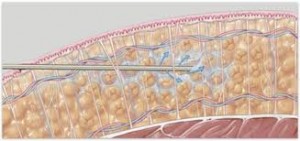Liposuction, introduced into the U.S. 32 years ago in 1981, is one of the most popular plastic surgery procedures performed. It is so commonly done it has worked its way into American culture as an instantly recognizeable term for what it does. Despite the recognizability of liposuction, how it actually works is not generally well understood.
At its very simplest, liposuction is a two-step process for removing fat. A hollow tube (cannula) is put under the skin, the tube is moved back and forth until the fat is dislodged, and the attached vacuum source pulls the fat out of the body.
Despite this apparent simplicity, there is much more science to it than that. Liposuction is much more than just ‘sticking a tube in and sucking it out’. The basic principles and physics of flow mechanics apply. There are three interesting components about liposuction, all of which contribute to its effectiveness and safety. These include the concept of tumescence or fluid infiltration, water vaporization and vacuum suction, and tubing size and design.

The first liposuction procedures were performed “dry,” meaning the fat was not infiltrated prior to performing liposuction. This led to what was removed (aspirate) containing 20% to 50% blood. Besides the blood loss, the amount of bruising and its persistence was nothing short of terrible. In 1985, the tumescent technique which is now universally used was introduced. Prior to performing liposuction the planned treated area is infiltrated with a large-volume, dilute lidocaine with epinephrine solution in order to minimize blood loss. A standard wetting solution is composed of 1 liter Lactated Ringers, 1 mL of 1:1000 epinephrine (1 mg) with 30 mL of 1% lidocaine. The amount of lidocaine infused per patient should not exceed the maximum recommended subcutaneous dose of 35 mg/kg, although the near immediate removal of some of the injected solution may allow doses up to 50 mg/kg to be used safely. Because the wetting solution is injected into the relatively avascular subcutaneous tissue in conjunction with the vasoconstrictive effects of epinephrine, systemic absorption occurs over 18 to 36 hrs and toxic levels of lidocaine are rarely reached.
A wetting solution not only provides local anesthetic for postoperative analgesia but also provides a vasoconstricting agent thereby minimizing intraoperative blood loss and bruising. Use of tumescent fluid with dilute epinephrine results in an average estimated blood loss that is estimated to be 1% to 3% of the total aspirate. The wetting solution also allows easier passage of the cannula through the tissue and minimizes intraoperative fluid requirements. The total amount of fluid that is injected is related to the total volume of aspirate. Patients undergoing low-volume aspirations (< 2 liters) will usually have the tumescent fluid injected in a 2-3:1 ratio to aspirate. Patients undergoing medium volume aspirations (2-4 liters) will usually have tumescent fluid injected in a 2:1 ratio. Patients undergoing large volume aspirations (>4 liters) will have fluid injected in a 1:1 ratio. Some doctors refer to the amount of fluid infused as wet (1:1 ratio) or super wet (2:1 or greater) tumescent infiltration. Only 25-35% of the infiltrate is removed during the fat removal part of the procedure. The rest of the infused fluids will be absorbed slowly over the next 6- to 12 hours postoperatively.
Tumescent infiltration in liposuction truly illustrates the old adage ‘you only get out of it what you put into it’.
Dr. Barry Eppley
Indianapolis, Indiana


